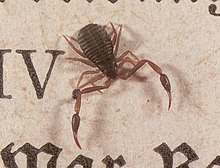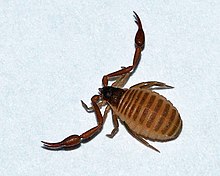Book scorpion
| Book scorpion | ||||||||||||
|---|---|---|---|---|---|---|---|---|---|---|---|---|

Book scorpion ( Chelifer cancroides ) |
||||||||||||
| Systematics | ||||||||||||
|
||||||||||||
| Scientific name of the genus | ||||||||||||
| Chelifer | ||||||||||||
| Geoffroy , 1762 | ||||||||||||
| Scientific name of the species | ||||||||||||
| Chelifer cancroides | ||||||||||||
| ( Linnaeus , 1758) |
The book scorpion ( Chelifer cancroides ) is probably the best-known representative of the pseudoscorpions in Central Europe . The animal, which is only a few millimeters in size, also occurs in people's living environment, where it is useful as a hunter of dust and book lice as well as house dust mites . The book scorpion is harmless to humans - it cannot penetrate human skin with its scissors.
features
As with all pseudoscorpions, the front body merges evenly into the rear body without narrowing. The body length is between 2.5 and 4.5 mm; the color is a light to darker brown. The striped-looking back panels of the rear body are divided in the middle by a fine longitudinal line. While the chelicerae (mouthparts) are only developed as very small, sessile scissors, the pedipalps represent very long scissor arms. In particular, the limb sections referred to as femur and patella are significantly longer than in related species. In addition to the long-looking scissor arms, book scorpions have four pairs of legs with which they can walk forwards and backwards equally well. Above the base of the pedipalps there is a small point eye on each side of the body. The sexes can hardly be distinguished.
In Central Europe alone there are more than 100 species and subspecies of pseudo- or afterscorpions - 49 of them in Germany, 63 in Switzerland and 69 in Austria. Some of these species are very similar to the book scorpion in terms of behavior and appearance ( e.g. Dactylochelifer latreillei and Mesochelifer ressli , both are also members of the Cheliferidae family) and can usually only be reliably determined down to the exact species by specialists. In the wild, you can meet the moss scorpions , which have a more angular front body and a shiny chitin shell.
Habitat and way of life
Book scorpions prefer dry locations and hide in narrow spaces. They can be found under the bark of dead pine trees, in beehives , old bird nests, stables, sheds and in people's homes. Here, for example, loose wallpaper and dusty books or files belong to their whereabouts. There they hunt even smaller animals, such as book lice and dust lice , springtails , bed bugs and mites . The prey is grasped with the pedipalp scissors and some poison is injected from a poison gland in the tip of the scissor finger. Then the mostly still wriggling victim is led to the small chelicerae and a hole is bitten in the body wall. As a result, digestive fluid is pumped into the prey and then sucked out.
In the Cheliceren also lead silk glands . With these, five to seven millimeter large web nests are made, into which the animal retreats to rest and also to winter.
The book scorpion is widespread in Central Europe, but one only occasionally comes across individual copies. The species occurs worldwide, probably as a result of human displacement. It appears more frequently in libraries, museums and herbaric collections .
Some related species, including the even smaller pseudoscorpion Lamprochernes nodosus , often cling to the legs of flies and can be transported through the area in this way (so-called phoresia ).
Habitat " Bien "
The biologist Alois Alfons published " The Enemy of the Bee Louse " in 1891 , and in 1951 Max Beier , a pseudoscorpion expert, published the article " The book scorpion, a welcome guest of the bee colonies ".
The German apologist Torben Schiffer has been researching "Pseudoscorpions as symbionts of bees" since 2006 . He sees the targeted use of book scorpions and species-appropriate beehives as a means against the varroa mite infestation in honey bees.
Reproduction and Individual Development
To reproduce, the male performs a courtship dance in front of the female, and then dance back and forth with him without the two touching each other. Then the male places a stalked sperm packet ( spermatophore ) on the ground, grabs the female with the pedipalps and pulls it over it.
The female carries the eggs with her around the genital opening under the abdomen in a brood pouch made from secretion and nourishes the embryos with the body's own nutrient solution. The eggs are laid in specially spun brood chambers. After hatching, the offspring need three moults through different nymph stages (proto-, deuto- and tritonymph) for their development to the finished book scorpion. This process takes several weeks.
Taxonomy and systematics
The books Scorpio was the father of modern taxonomy, Carl Linnaeus , as Acarus cancroides firstdescribed - the species was accordingly so from him, the genus assignment to the mites counted. The species name cancroides can be translated as crab-like . It is one of only two pseudoscorpion species considered by Linnaeus. From Linnaeus' brief species diagnosis “ Acarus antennis cheliformibus, abdomine ovato depresso ” (mite with scissor-shaped antennae and oval, flattened abdomen) it is actually impossible to deduce which species actually existed at that time - there is no type material anymore. From the tradition and the use of the name by the following generations of arachnologists, one can conclude with some certainty that the book scorpion must have been meant.
The French naturalist Étienne Louis Geoffroy (1725-1810) transferred the species in 1762 to the genus Chelifer , in which it has remained ever since. For the biological nomenclature, however, the difficulty arose that Geoffroy's work (which he had published anonymously) should not actually be used for nomenclature purposes. In 1989, the ICZN saw itself compelled to formally establish the generic name. The book scorpion is the only species of the (thus monotypical ) genus Chelifer . A total of 346 species of this genus have been scientifically described over the centuries. All but the book scorpion were transferred to other genera described later or synonymous with other species (plus 14 species names, which are nouns dubia ).
In addition to the nominate form , a subspecies of the book scorpion was recognized until 2014 : Chelifer cancroides orientalis Morikawa, 1954 from Japan. However, recent studies have shown that the East Asian animals, although generally somewhat smaller, cannot really be separated from the rest - the characteristics vary clinically . Accordingly, subspecies are no longer differentiated.
literature
- Heiko Bellmann: Spiders, crabs, millipedes. European arthropods (excluding insects). Steinbach's natural guide, Mosaik-Verlag, Munich 1991. ISBN 3-570-06450-6
Web links
- Rescue for our bees? A researcher gives hope for the future , NDR documentary, 45 min, April 15, 2019
Individual evidence
- ↑ "Checklist of the Pseudoscorpions of Central Europe" at www.arages.de (link to a PDF download there)
- ^ Theo Blick & Christoph Muster: Red List of Endangered Pseudoscorpions (Arachnida: Pseudoscorpiones) Bavaria. BAYLfU 166/2003. ( PDF online )
- ↑ Beenature Project - Back to Nature. Retrieved April 21, 2019 .
- ↑ Max Beier: The book scorpion, a welcome guest of the bee colonies. In: Österreichischer Imker Vol. 1, 1951, pp. 209–211.
- ↑ Patrick Spät: Will a scorpion save the honey bee? Telepolis , November 21, 2013, accessed the same day.
- ↑ Torben Schiffer: Beenature Project. Retrieved April 21, 2019 .
- ↑ P. Appelhans: "Pseudoscorpions". Overview at www.natur-in-nrw.de
- ↑ Mark S. Harvey (2007): The smaller arachnid orders: diversity, descriptions and distributions from Linnaeus to the present (1758 to 2007). Zootaxa 1668: 363-380.
- ↑ There are two damaged specimens in the collection, today administered by the Linnean Society in London: LINN 7004 LINN 7005 , whose species is unclear.
- ↑ International Commission on Zoological Nomenclature (1989): Opinion 1542. Chelifer Geoffroy, 1762 (Arachnida, Pseudoscorpionida) conserved. Bulletin of Zoological Nomenclature 46: 143-144.
- ↑ a b Mark S. Harvey (2014): A review and redescription of the cosmopolitan pseudoscorpion Chelifer cancroides (Pseudoscorpiones: Cheliferidae). Journal of Arachnology 42 (1): 86-104. doi : 10.1636 / K13-57.1

